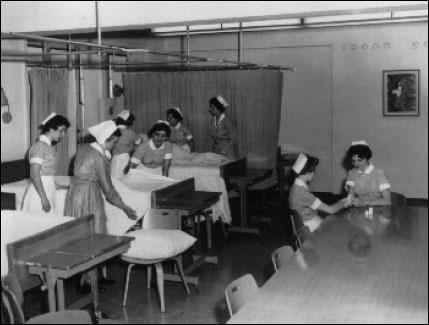
Today, fewer nurses are available to meet patients’ many needs. Reproduced from originals in the Center for the Study of the History of Nursing, School of Nursing, University of Pennsylvania.
I am a professional nurse. I live in a nation that spends astronomical amounts of money on health care. I work within a health care system that has the ability to provide excellent preventative measures, diagnosis, treatment and care to people. But all of this depends upon patient access to not only doctors who can prescribe treatments, but to skilled nurses whose care is essential to recovering and maintaining the well-being of patients.
Yet where in the news media and public debate do we find attention to the fact that this country has systematically curtailed expert nursing care? To cope with growing health care costs, insurers have incrementally changed what constitutes grounds for hospital admission as well as appropriate parameters for discharge, and at the same time ignored the role that skilled nurses in a hospital setting can and do play in patients’ treatment.
Patients who would have been admitted to the hospital 15 years ago are now routinely denied admission. Those cared for in the hospital are more acutely ill than ever before, and they are often discharged while they are still in need of nursing care. Because of their greater degree of illness, patients today need more attentive nursing care. Yet, in hospitals we often have too few nurses to manage their care on busy nursing units. This has made it difficult for me and thousands of other nurses like me to ensure that patients get the care that they deserve, the best care that we know how to provide.
This is what it is like to be a nurse in the hospital today. As I help an elderly woman from the wheelchair into a hospital bed, my assessment is quick and easy—moderately severe dehydration, fever, productive cough, dizziness, nausea. I immediately hang intravenous fluids, treat the fever and nausea, and move her to a room adjacent to the nurses’ station where she can be observed frequently and receive help quickly if she tries to get out of bed. Her attending physician comes in and shares his frustrations. “She’s been in the emergency room twice over the past weekend. It’s probably just bronchitis, but I begged them to admit her this time because I was afraid if they sent her home again, she would die,” this doctor told me.
When did we, as a system, start to ignore the all-too-evident needs of patients when they fail to fit into tidy medical admission categories? How much professional nursing time will be spent, not on treating this woman’s very real health problems, but on ensuring that the wording in the chart will help the hospital to be reimbursed for this care? The answer: too much!
I spend 40 minutes in conversation with a wakeful patient in the middle of the night. Admitted because she hemorrhaged after treatment of a recently diagnosed tumor, she is unable to sleep while she wonders what will happen to her family now that they have entered the unfamiliar and uncertain terrain of cancer. How will her young children cope with her illness? How can she help her husband manage his anger, depression and grief at this catastrophe? Her nurses and physicians have aggressively managed and stabilized her physical condition over the past two days, but nobody has had a chance to help her understand what this will mean to her life. Our conversation helps her to understand her current and future treatment plans, to articulate the questions that she needs to ask her oncologists, and to start planning for family supports.
Comforted, she is able to sleep.
Continuing my rounds, I find another patient well into a severe asthma attack. After arranging for treatment of his crisis and transferring him to a critical care unit, I am left feeling overwhelmed. With so many patients who are so very ill, how many places can I be at once? Several months later, when I read the cancer patient’s obituary, I know her need for my care was as great as the respiratory patient’s. I am grateful that I was able to help her sort through the tangle of emotions and fears that prevented her from resting that night. Yet I also know that if I had evaluated the other patient sooner, he might have been stabilized without the necessity of intensive care.
I recall the sinking feeling of finding a patient, weakened by illness, on the floor next to his bed. He has fallen while trying to get to the bathroom unassisted—he did not want to bother me, knowing that I am very busy. As I carefully lift him back to bed and evaluate for possible head injury or hip fracture, I realize that it has been over 30 minutes since I last passed here—how long ago did he fall? While I am bathing him and changing his soiled hospital gown prior to sending him for emergency x-rays, I realize that a diabetic patient’s evening insulin dose will now be at least 45 minutes late, and wonder if yet another patient’s pain medication has worn off. I know that it will be another 20 minutes before I can check in on him.
Nowhere does the poverty of access to nursing care become more evident than when I am attempting to prepare a family to take home a frail parent. There is always a lot of teaching and preparation to be done, a lot for a family to learn: how to manage the medications; how to help with walking, balancing, bathing; how to tell when the disease is getting worse, and whom to call in an emergency. The visiting nurses from the home care agency will be in to see and evaluate the patient, and home health assistants will come in several times weekly, but the brunt of the responsibility will rest on the shoulders of sons, daughters, nieces, nephews and grandchildren—anyone who can pitch in and help.
Now, even as I assure the family that the home care nurse will be out tomorrow to evaluate the situation, I wonder how many visits will be allowed? With the latest cutbacks in reimbursement for the care of our sickest and frailest patients, ongoing professional evaluation and support that has enabled families to care for their elders at home is being terminated soon after discharge from the hospital.
As I read an article in my local paper about patient deaths, it seems to me that inadequate staffing may be a factor. I am frustrated to once again see that obvious questions are not being addressed: How many nurses were on the unit that night? How many patients were they caring for? How sick were those patients? How much necessary care, monitoring, surveillance, could not be attended to despite the best efforts of nurses who probably did not sit down once all night?
The article zeroed in on automated alarm systems, questioning whether they were they functioning or adequate. It makes me wonder how the reporters can fail to realize that an alarm can only trigger a prompt assessment. If the nurse is not available to respond, then the alarm is useless. Why did these investigative journalists fail to ask nurses what might have happened to result in these patients’ deaths?
The fiscal realities that drive the impoverishment of care are very real. But our citizens have never declared that the professional nurses whose care provides comfort, dignity, education and safety are luxuries that we can no longer afford. It’s just happening, and nobody—least of all journalists—seems to be paying attention.
Jean Chaisson has 19 years of experience as a registered nurse in hospital care. Since 1984 she has been a clinical nurse and nurse specialist at a major Boston teaching hospital.



